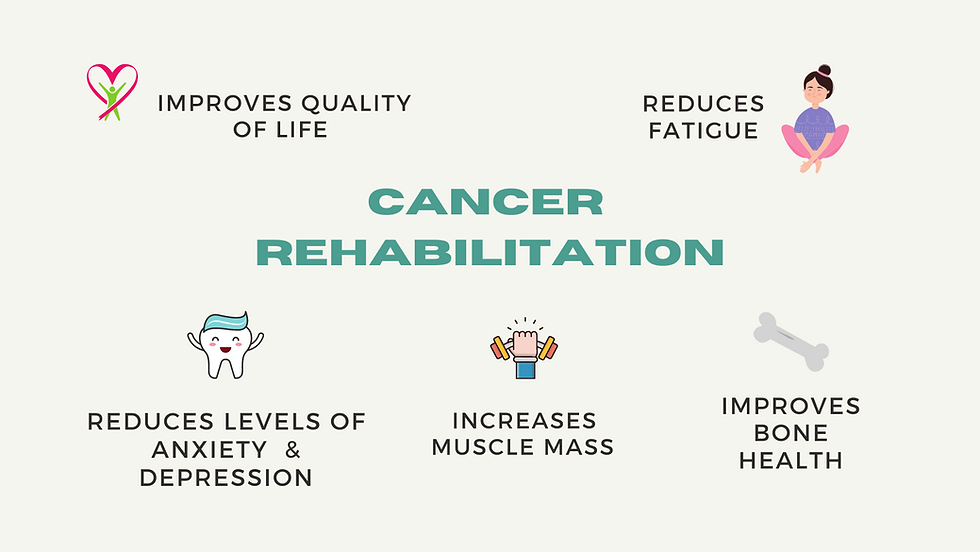Cancer Rehabilitation: Supporting those living with and beyond cancer
- rachelevansphysio
- Sep 23, 2022
- 3 min read
We’ve been promoting Cancer Rehab Awareness Week this week with Fighting Fit for Cancer. Read on to find out more about the role of Cancer Rehab and how it can help those with a cancer diagnosis during and after treatment….
Exercise and physical activity is now increasingly recognised as a key component of cancer care. In the last 10 years more than 2500 randomised controlled exercise trials in cancer have been published driving exercise to be the standard of care in oncology, as it is for heart disease.
In 2018 the Clinical Oncology Society of Australia published formal guidelines (1) that advise that exercise should be prescribed as a routine part of cancer care, and similar recommendations have followed in US and in Europe.
What are the benefits of exercise for those with a cancer diagnosis?
70% of those diagnosed with cancer are struggling with physical side effects up to ten years after treatment (2). There is a growing body of evidence that shows exercise and rehabilitation can help prevent and manage these side effects. Taking part in regular exercise and physical activity after diagnosis is associated with reduced levels of fatigue, improvements in physical strength and function and improved bone health.
As well as the physical impact of cancer and its treatments, two in five people are affected by depression after their diagnosis and over two thirds of those diagnosed require emotional support (3). Remaining active and having an exercise routine has been shown to improve levels of anxiety and depression, which, when combined with the physical benefits means cancer rehabilitation has a key role to play in improving the quality of life for those with a cancer diagnosis.

What is Cancer Rehabilitation?
Cancer rehabilitation consists of support to improve quality of life at different stages of treatment and beyond. It plays an important role in post-surgical recovery and it is effective alongside chemotherapy and radiotherapy treatments. Cancer rehab can also help those with advanced cancers to maintain their quality of life and remain as active as possible. Normally led by a Physiotherapist with specialist training in cancer rehab, it can include individualised exercise programming, hands on treatment and specific and advice and support, helping those with cancer to maximise their own recovery and take positive steps for their health and wellbeing.
Despite the evidence supporting cancer rehab and the increasing numbers of people reporting the benefits, one to two thirds of people living with or beyond cancer are completely inactive and a relatively small proportion of people are accessing cancer rehab services.
How can I access Cancer Rehabilitation?
You can access specialist trained physiotherapists in Cancer Rehabilitation around the UK. If you based in Buckinghamshire or Berkshire get in touch with Rachel here to discuss how she can support your treatment and recovery. You can find a list of other cancer rehab trained physiotherapists here. You can also access services through your local NHS services; speak to your Oncology team or Cancer Nurse to find out more.
How can I support Cancer Rehabilitation?
The PINC & STEEL Cancer Rehabilitation Foundation UK & Ireland is a registered charity with a mission to make rehabilitation after a cancer diagnosis accessible to all. Their goal is to actively support thousands of people across the UK & Ireland to move over cancer each year.
If you would like to donate to support cancer rehabilitation and read more on their awareness campaign, click here.

1.Cormie et al (2018) Clinical Oncology Society of Australia position statement on exercise in cancer care. Med J Aus. Aug 20;209(4):184-187 2. Macmillan Cancer Support (2009) It's no life: living with the long-term effects of cancer. 3. Macmillan Cancer Support (2013) Cured- But at What Cost?





Comments